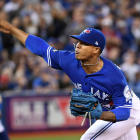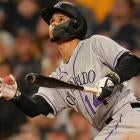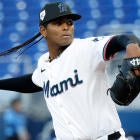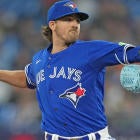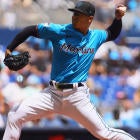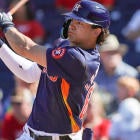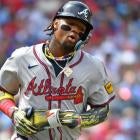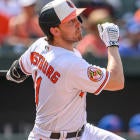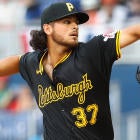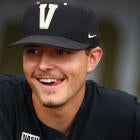Rick Porcello is going to be a popular regression candidate in Fantasy circles in 2017, and for good reason.
After years of an established track record as a roughly league average pitcher, Porcello took a huge step forward, improving his ERA by more than a run and a half en route to the 2016 AL Cy Young.
However, Porcello wasn't all smoke and mirrors. He got a little bit lucky, perhaps, but really did pitch better than any other point in his career. He posted the highest strikeout rate of his career at 21.2 percent, and combined it with his best walk rate -- 3.6 percent -- which goes a long way toward explaining why he put together the best results of his career.
Porcello's improvement wasn't obvious, but the previous career bests in both strikeout and walk rate came in 2015, so in hindsight, it makes some sense. Porcello has always had the tools to be an above average pitcher, and he had it all come together in 2016 for a career season.
Porcello is just the latest example of an established pitcher taking a big step forward, and he won't be the last. Identifying who will be the next can be a key to your Fantasy season, so here are a few candidates to be this year's Porcello.
Marcus Stroman isn't as established as Porcello, but he might be the closest analogue, as a pitch-to-contact pitcher who got bit by some bad luck on battled balls last season. His 4.37 ERA certainly doesn't scream "Cy Young candidate," but the 3.71 FIP and 3.62 SIERA tell the story of a pitcher who was better than his raw numbers indicate.
Stroman's two biggest issues in 2016 were two things that tend to fluctuate quite a bit from one year to the other: home runs and stranding runners. Stroman sported just a 68.6 percent strand rate last season and a 16.5 percent HR/FB rate, both of which ranked in the bottom 10 among qualified starters. Those issues aren't entirely luck-related, of course -- Stroman wouldn't be the first young pitcher to struggle with runners on base -- but we don't exactly have enough evidence in his career to say that definitively.
Stroman also took a big step forward in the second half last year, and that could be the beginning of big things. His ERA fell to 3.68 after the All-Star break and that was backed up by a drop to 3.49 in his FIP. Stroman posted a 22.7 percent strikeout rate, while lowering his walk rate to 5.8 percent. We might have seen the first inklings of Stroman's ascendance to the ace tier last season, because if he can combine that strikeout rate with his extreme groundball tendencies, he certainly has the makings of a star.
If Jon Gray pitched pretty much anywhere else, he might already be a Cy Young contender. Armed with a fastball that sits comfortably in the mid-90s and a slider that he established quickly as one of the best weapons in baseball last season, the biggest thing standing in his way is Coors Field. Unfortunately, that might be a Rocky mountain-sized obstacle for the young flame-thrower to overcome.
How big is that obstacle, exactly? Well, since 2007, only one Rockies pitcher has posted an ERA below 3.00 for a full season while qualifying for the ERA title, and there have only been eight individual seasons with an ERA below 4.00 in at least 150 innings in that time. However, Gray does have a lot going for him beyond that, leading with the fact that he sported the fourth-best FIP among those 21 pitchers over the last 10 years.
The biggest issue with pitching at Coors Field is what it does to balls in play. It turns them into hits at an extremely high rate, and the Rockies have long tried to figure out what the best way to mitigate that is. They have tried groundball pitchers, but Gray might have figured out the best way to do it so far -- don't allow any balls in play. His 26.0 percent strikeout rate is the best of any Rockies pitcher in franchise history with at least 100 innings pitched.
Turning into a Fantasy-relevant pitcher at Coors Field is tough, but Gray may just be the best-equipped player in Rockies history to do it. Reaching that ace level might be too much to ask, but if Gray can even get into the mid-3.00 ERA range at home, he could be good enough on the road to be a must-start pitcher no matter where he is.
We've seen Drew Smyly pitch at this level before, though never for a full season, which is a big part of why it's hard to get excited about him. The closest he has ever come was when he sported a 3.24 ERA in 153 innings in 2014, though he really impressed with a 3.11 ERA and 10.40 K/9 in 66 2/3 innings in 2015. The problem is, with multiple shoulder injuries in his past, it might be tough for Smyly to make it through a full season, even if he can hit that point again.
However, right now, the biggest question might be whether he can even reach that level. His 2016 campaign was a disaster. Smyly mostly managed to stay healthy, but surrendered a 4.88 ERA in his 175 1/3 innings of work. His strikeout rate regressed to 22.6 percent, and that wasn't enough to overcome his serious homer issues. Smyly is an extreme flyball pitcher and he got bit hard by 1.64 HR/9 last season.
If Smyly can't do a better job keeping the ball in the yard, there might be no reason to even talk about him, but the bright spots are still bright enough that you can't write him off. And, though he isn't moving into a better park for homer suppression, the move from Tampa Bay to Seattle should bring elite outfield defense with it, at least, Jarrod Dyson, Mitch Haniger, and Leonys Martin giving the Mariners three players who can all handle center field playing next to each other. That could turn a few doubles or triples into outs, which always helps.
Of course, it's all going to come down to those homers. Smyly has one big problem, but if he can just get that into the acceptable range, he could see huge improvements. This isn't just a small tweak, of course, which makes Smyly a huge long shot -- which is why you might be able to grab him in the later rounds on Draft Day -- but with just a few tweaks, we've seen how good he can be.



















